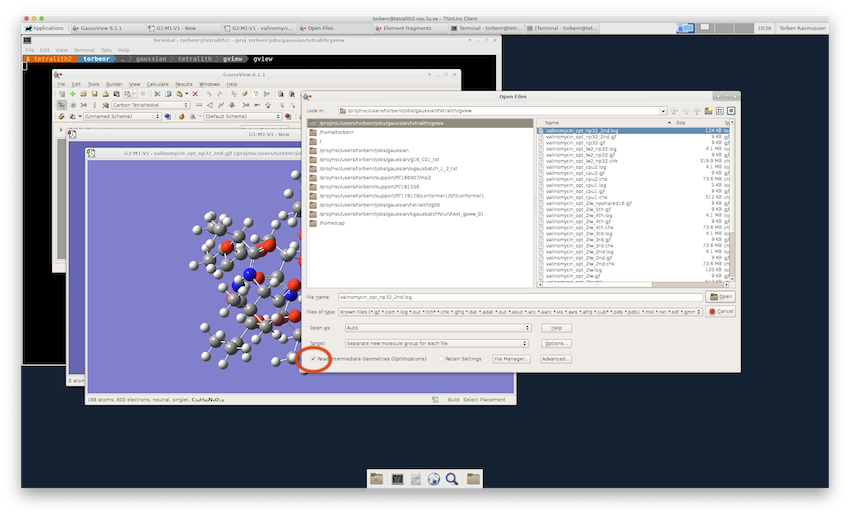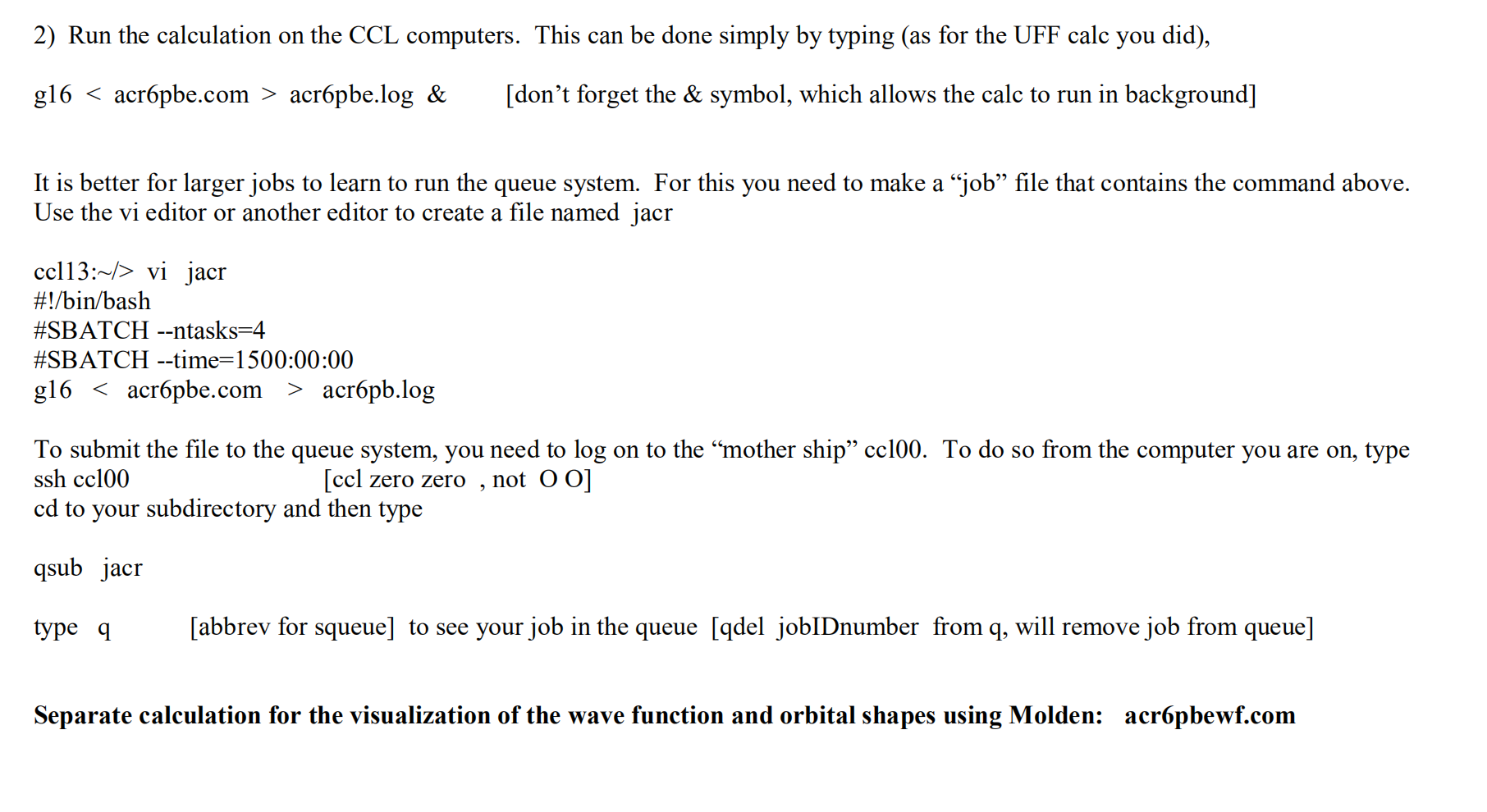Read Checkpoint File Gaussian
There are three molecular mechanics methods available in Gaussian. They were implemented for use in ONIOM calculations, but they are also available as independent methods. No basis set keyword should be specified with these keywords.
The following force fields are available:
The Gaussian computational chemistry program allows the results of a calculation to be saved in a machine readable file, called a checkpoint file. The primary use of a checkpoint file is to use the results of one calculation as the starting point for a second calculation.
AMBER: The AMBER force field as described in [37]. The actual parameters (parm96.dat) have been updated slightly since the publication of this paper. We use this current version from the AMBER web site (amber.scripps.edu).
DREIDING: The DREIDING force field as described in [38].
- Chimera can read molecular structures from formatted Gaussian checkpoint files. This file type is indicated by the filename suffix.fchk or by using prefix:filename in the command line, where prefix is fchk or gaussian. The Atomic numbers and Current cartesian coordinates sections of the file are read to generate the structure.
- Aug 14, 2016 Locating the Read-Write File for a Job. If you did not use%RWF in the original interrupted job to name a read-write file, then you may be able to find the read-write file in the Gaussian scratch directory (specified by the GAUSSSCRDIR environment variable). It will have the default name assigned by Gaussian, which is of the form Gau.
UFF: The UFF force field as described in [39].
in front of each ESP, and let FO4 launcher control everything. I have only six ESP mod files, and I am hoping that I can bypass FO4 stating, when attempting to load my current character, that there are items 'missing' and do I wish to continue.Everything was fine thru 1.4 - ESPs placed under Data folder and plugins.txt made 'read-only'.I must be missing something, as I've removed the 'read-only', placed the '.' My issue appears to be the mod itself. Yet I still get that popup, and then use MOD in main menu to enable and select launch order. I already had a Beth account.I noticed that FO4 places my ESP files into the DLClist.txt file, and apparently doesn't touch plugins.txt any longer.BTW, I have no DLCs installed.So basically, any suggestions on how to have the ESP files placed and into which files so that FO4 will simply launch, correctly, with the mods already enabled, thus bypassing the popup?TIA - have gotten some great tips from other discussions here. How to merge esp files fallout 4.
Read Checkpoint File Gaussian Free

CHARGE ASSIGNMENT-RELATED OPTIONS
Unless set in the molecule specification input, no charges are assigned to atoms by default when using any molecular mechanics force field. Options are available to estimate charges at the initial point using the QEq algorithm under control of the following options for any of the mechanics keywords:
QEq
Assign charges to all atoms using the QEq method [40].
UnTyped
Assign QEq charges only to those atoms for which the user did not specify a particular type in the input.
UnCharged
Assign QEq charges for all atoms which have charge zero (i.e., all atoms which were untyped or which were given a type but not a charge in the input).
PARAMETER PRECEDENCE OPTIONS
Terminology: Gaussian contains built-in parameter sets for the built-in force fields listed above; these are referred to as hard-wired parameters. Soft parameters are ones specified by the user in the input stream for the current job (or a previous job when reading parameters from the checkpoint file). By default, when no relevant option is given, the hard-wired parameters are the only ones used.
HardFirst
Read additional parameters from the input stream, with hard-wired parameters having priority over the read-in, soft ones. Hence, read-in parameters are used only if there is no corresponding hard-wired value. Note that wildcards matches within the hardwared parameter set take precidence over soft parameters, even when the latter contains an exact match for the same item. Use SoftFirst if you want to override hard-wired parameter matches.
SoftFirst
Read additional parameters from the input stream, with soft (read-in) parameters having priority over the hard-wired values.
SoftOnly
Read parameters from the input stream and use only them, ignoring hard-wired parameters.
ChkParameters
Read parameters from the checkpoint file. Any non-standard (soft) parameters present in the checkpoint file are used with higher priority than corresponding hard-wired parameters, unless HardFirst is also specified.
NewParameters
Ignore any parameters in the checkpoint file.
Modify
Read modifications and additions to the parameter set (after it has been constructed from hard and/or soft parameters).
HANDLING MULTIPLE PARAMETER SPECIFICATION MATCHES
Since parameters can be specified using wildcards, it is possible for more than one parameter specification to match a given structure. The default is to abort if there are any ambiguities in the force field. The following options specify other ways of dealing with multiple matches.
FirstEquiv If there are equivalent matches for a required parameter, use the first one found.
LastEquiv
If there are equivalent matches for a required parameter, use the last one found.
INPUT CONVENTIONS
AMBER calculations require that all atom types be explicitly specified using the usual notation within the normal molecule specification section:
Consult the AMBER paper [37] for definitions of atom types and their associated keywords.
Atom types and charges may also be provided for UFF and DREIDING calculations, but they are not required. For these methods, the program will attempt to determine atom types automatically.
Analytic energies, gradients, and frequencies.
ONIOM, Geom=Connect
GENERAL MOLECULAR MECHANICS FORCE FIELD SPECIFICATIONS
Unless otherwise indicated, distances are in Angstroms, angles are in degrees, energies are in Kcal/mol and charges are in atomic units. Function equivalencies to those found in standard force fields are indicated in parentheses. In equations, R refers to distances and θ refers to angles.
Wildcards may be used in any function definition. They are indicated by a 0 or an asterisk.
In MM force fields, the non-bonded (Vanderwaals and electrostatic) interactions are evaluated for every possible pair of atoms. However, interactions between pairs of atoms that are separated by three bonds or less are usually scaled down (in most force fields, using a factor 0.0 for pairs separated by one or two bonds, and some value between 0.0 and 1.0 for pairs that are separated by three bonds).
There are a number of ways to implement the calculation of non-bonded interactions. We follow a two-step procedure. First, we calculate the interactions between all pairs, without taking the scaling into account. In this step, we can use computationally efficient (linear scaling) algorithms. In the second step, we subtract out the contributions that should have been scaled, but were included in the first step. Since this involves only pairs that are close to each other based on the connectivity, the computer time for this step scales again linearly with the size of the system. Although at first sight it seems that too much work is done, the overall algorithm is the more efficient than the alternatives.
In the soft force field input, the NBDir function entry corresponds to the calculation of all the pairs, and the NBTerm entry is used for the subsequent subtraction of the individual pairs. However, to make things easier, you can specify just the non-bonded master function NonBon, which is automatically expanded into the actual functions NBDir and NBTerm during pre-processing.
Vanderwaals parameters, used for NBDir and NBTerm (See MMFF94 below for MMFF94-type Vanderwaals parameters).
VDWBond-length Well-depth
MMFF94 type Vanderwaals parameters (used for NBDir and NBTerm).
VDW94Atomic-pol NE Scale1 Scale2 DFlag
Atomic-pol Atomic polarizability (Angstrom3).
NE Slater-Kirkwood effective number of valence electrons (dimensionless).
Scale1 Scale factor (Angstrom1/4).
Scale2 Scale factor (dimensionless).
DFlag 1.0 for donor type atom, 2.0 for acceptor type, otherwise 0.0.
MMFF94 electrostatic buffering
Buf94Atom-type Value
Non-bonded interaction master function. This function will be expanded into pairs and a direct function (NBDir and NBTerm) before evaluation of the MM energy.
NonBonV-Type C-Type, V-Cutoff C-Cutoff VScale1 VScale2 VScale3 CScale1 CScale2 CScale3
V-Type is the Vanderwaals type:
0 No Vanderwaals
1 Arithmetic (as for Dreiding)
2 Geometric (as for UFF)
3 Arithmetic (as for Amber)
4 MMFF94-type Vanderwaals
C-Type is the Coulomb type:
0 No Coulomb
1 1/R
2 1/R2
3 1/R buffered (MMFF94)
V-Cutoff and C-Cutoff are the Vanderwaals and Coulomb cutoffs (respectively):
0 No cutoff
>0 Hard cutoff
<0 Soft cutoff
VScale1-3 are Vanderwaals scale factors for 1 to 3 bond separated pairs. CScale1-3 are Coulomb scale factors for 1 to 3 bond separated pairs. If any scale factor < 0.0, the 1/1.2 scaling is used (as for Amber).
Coulomb and Vanderwaals direct (evaluated for all atom pairs).
NBDirV-Type C-Type V-Cutoff C-Cutoff
V-Type, C-Type, V-Cutoff, and C-Cutoff as above.
Coulomb and Vanderwaals single term cutoffs
NBTermAtom-type1 Atom-type2 V-Type C-Type V-Cutoff C-Cutoff V-Scale C-Scale
V-Type, C-Type, V-Cutoff, C-Cutoff, V-Scale, and C-Scale as above.
Atomic single bond radius

AtRadAtom-type Radius
Effective charge (UFF)
EffChgCharge
GMP Electronegativity (UFF)
EleNegValue
Step down table
TableOriginal-atom-type Stepping-down-type(s).
Harmonic stretch I (Amber [1]): ForceC*(R-Req)2
HrmStr1Atom-type1 Atom-type2 ForceC Req
ForceC Force constant
Req Equilibrium bond length
Harmonic stretch II (Dreiding [4a]): ForceC*[R-(Ri+Rj-Delta)]2
HrmStr2 Atom-type1 Atom-type2 ForceC Delta
ForceC Force constant
Delta Delta
Ri and Rj are atomic bond radii specified with AtRad.
Harmonic stretch III (UFF [1a]): k*(R-Rij)2
Equilibrium bond length Rij = (1 - PropC*lnBO)*(Ri + Rj) + Ren
Force constant: k = 664.12*Zi*Zj/(Rij3)
Electronegativity correction: Ri*Rj*[Sqrt(Xi) - Sqrt(Xj)]2/(Xi*Ri + Xj*Rj)
HrmStr3Atom-type1 Atom-type2 BO PropC
BO Bond order (if <0, it is determined on-the-fly)
PropC Proportionality constant
Ri and Rj are atomic bond radii defined with AtRad. Xi and Xj are GMP electronegativity values defined with EleNeg. Zi and Zj are the effective atomic charges defined with EffChg.
Morse stretch I (Amber): DLim*(e-a(R-Req)-1)2 where a = Sqrt(ForceC/DLim)
MrsStr1 Atom-type1 Atom-type2 ForceC Req DLim
ForceC Force constant
Req Equilibrium bond length
DLim Dissociation limit
Morse stretch II (Dreiding [5a]): DLim*exp[-a(Ri+Rj-Delta)]-1)2 where a = Sqrt(ForceC/DLim)
MrsStr2 Atom-type1 Atom-type2 ForceC Delta DLim
ForceC Force constant
Delta Delta
DLim Dissociation limit
Ri and Rj are atomic bond radii defined with AtRad.
Morse stretch III (UFF [1b]): A1*A3*(exp[-a(R-Rij)]-1)2 where a = Sqrt(k/[BO*PropC])
Equilibrium bond length Rij = (1 - PropC*lnBO)*(Ri + Rj) + Ren
Force constant k = 664.12*Zi*Zj/Rij3
Electronegativity correction: Ren = Ri*Rj*(Sqrt(Xi) - Sqrt(Xj))2/(Xi*Ri + Xj*Rj)
MrsStr3Atom-type1 Atom-type2 BO PropC
BO Bond order (if <0, it is determined on-the-fly)
PropC Proportionality constant
Ri and Rj are atomic bond radii defined with AtRad. Xi and Xj are GMP electronegativity values defined with EleNeg. Zi and Zj are the effective atomic charges defined with EffChg.
Quartic stretch I (MMFF94 [2]):
(Req/2)*(R-ForceC)2*[1+CStr*(R-ForceC+(7/12)*CStr2*(R-ForceC)2]
QStr1Atom-type1 Atom-type2 ForceC Req CStr
ForceC Force constant (md-Angstrom-1)
Req Equilibrium bond length (Angstrom)
CStr Cubic stretch constant (Angstrom-1)
Atomic torsional barrier for the oxygen column (UFF [16])
UFFVOx Barrier
Atomic sp3 torsional barrier (UFF [16])
UFFVsp3 Barrier
Atomic sp2 torsional barrier (UFF [17])
UFFVsp2 Barrier
Harmonic bend (Amber [1]): ForceC*(T-θeq)2
HrmBnd1 Atom-type1 Atom-type2 Atom-type3 ForceC θeq
ForceC Force constant (in kcal/(mol*rad2)
θeq Equilibrium angle
Harmonic Bend (Dreiding [10a]): [ForceC/sin(θeq2)]*(cos(θ)-cos(θeq))2
HrmBnd2 Atom-type1 Atom-type2 Atom-type3 ForceC θeq
ForceC Force constant
θeq Equilibrium angle
Dreiding Linear Bend (Dreiding [10c]): AForceC*(1+cos(θ))
LinBnd1 Atom-type1 Atom-type2 Atom-type3 ForceC
ForceC Force constant
UFF 3-term bend (UFF [11]):
k*(C0 + C1*cos(θ))+C2*cos(2θ) where C2=1/(4 * sin(θeq2)),
C1 = -4*C2*cos(θeq) and C0=C2*(2*cos(θeq2)+1)
Force constant: k = 664.12*Zi*Zk*(3*Rij*Rjk*(1-cos(θeq2))-cos(θeq)*Rik2)/Rik5
UFFBnd3 Atom-type1 Atom-type2 Atom-type3 θeqBO12BO23PropC
θeq Equilibrium angle
BO12 Bond order for Atom-type1–Atom-type2 (when <0, it is determined on-the-fly)
BO23 Bond order for Atom-type2–Atom-type3 (when <0, it is determined on-the-fly)
PropC Proportionality constant
Ri, Rj and Rk are atomic bond radii defined with AtRad. Xi, Xj and Xk are GMP electronegativity defined with EleNeg. Zi, Zj and Zk are effective atomic charges defined with EffChg.
UFF 2-term bend (UFF [10]): [k/(Per2)]*[1-cos(Per*θ)]
Force constant: k = 664.12*Zi*Zk*(3*Rij*Rjk*(1-cos(Per2))-cos(Per)*Rik2)/Rik5
UFFBnd2 Atom-type1 Atom-type2 Atom-type3 Per BO12BO23PropC
Per Periodicity: 2 for linear, 3 for trigonal, 4 for square-planar.
BO12 Bond order for Atom-type1–Atom-type2 (when <0, it is determined on-the-fly)
BO23 Bond order for Atom-type2–Atom-type3 (when <0, it is determined on-the-fly)
PropC Proportionality constant
Read Checkpoint File Gaussian Pdf
Ri, Rj and Rk are atomic bond radii defined with AtRad. Xi, Xj and Xk are GMP electronegativity defined with EleNeg. Zi, Zj and Zk are effective atomic charges defined with EffChg.
Zero bend term: used in rare cases where a bend is zero. This term is needed for the program not to protest about undefined angles.
ZeroBndAtom-type1 Atom-type2 Atom-type3

Cubic bend I (MMFF94 [3]): (ForceC/2)*(1+CBend*(θ-θeq))*(θ-θeq)2
CubBnd1Atom-type1 Atom-type2 Atom-type3 ForceC θeqCBend
ForceC Force constant (in md*Angstrom/rad2)
θeq Equilibrium angle
CBend 'Cubic Bend' constant (in deg-1)
MMFF94 Linear Bend (MMFF94 [4]): ForceC*(1+cos(θ))
LinBnd2Atom-type1 Atom-type2 Atom-type3 ForceC
ForceC Force constant (md)
Amber torsion (Amber [1]): Σi=1,4 (Magi*[1+cos(i*θ-I(i+4))])/NPaths
AmbTrsAtom-type1 A-type2 A-type3 A-type4 PO1 PO2 PO3 PO4 Mag1Mag2Mag3Mag4NPaths
PO1-PO4 Phase offsets
Mag1..Mag4V/2 magnitudes
NPaths Number of paths (if < 0, determined on-the-fly).
Dreiding torsion (Dreiding [13]): V*[1-cos(Period*(θ-PO))]/(2*NPaths)
DreiTrsAtom-type1 Atom-type2 Atom-type3 Atom-type4 V PO Period NPaths
V Barrier height V
PO Phase offset
Period Periodicity
NPaths Number of paths (if < 0, determined on-the-fly).
UFF torsion with constant barrier height (UFF [15]): [V/2]*[1-cos(Period*PO)*cos(V*θ)]/NPaths
UFFTorC Atom-type1 Atom-type2 Atom-type3 Atom-type4 Period PO V NPaths
Period Periodicity
PO Phase offset
V Barrier height V
NPaths Number of paths. When zero or less, determined on-the-fly.
UFF torsion with bond order based barrier height (UFF [17]):
[V/2]*[1-cos(Period*PO)* cos(Period*θ)]/NPaths where V = 5*Sqrt(Uj*Uk)*[1+4.18*Log(BO12)]
UFFTorB Atom-type1 Atom-type2 Atom-type3 Atom-type4 Period POBO12NPaths
Period Periodicity
PO Phase offset
BO12 Bond order for Atom-type1–Atom-type2 (when <0, it is determined on-the-fly)
NPaths Number of paths (when <0, it is determined on-the-fly)
Uj and Uk are atomic constants defined with UFFVsp2.
UFF torsion with atom type-based barrier height (UFF [16]):
[V/2]*[1-cos(Period*PO)* cos(Period*θ)]/NPaths where V=Sqrt(Vj*Vk)
UFFTor1Atom-type1 Atom-type2 Atom-type3 Atom-type4 Period PO NPaths
Period Periodicity
PO Phase offset
NPaths Number of paths. When zero or less, determined on-the-fly.
Vj and Vk are atomic constants defined with UFFVsp3.
UFF torsion with atom type based barrier height (UFF [16]) (differs from UFFTor1 in that the atomic parameter that is used): [V/2]*[1-cos(Period*PO)*cos(Period*θ)]/NPAths where V=Sqrt(Vj*Vk)
UFFTor2 Atom-type1 Atom-type2 Atom-type3 Atom-type4 Period PO NPaths
Period Periodicity
PO Phase offset
NPaths Number of paths. When zero or less, determined on-the-fly.
Vj and Vk are atomic constants from UFFVOx.
Dreiding special torsion for compatibility with Gaussian 98 code. During processing, it is replaced with DreiTRS, with the following parameters:

If there are three atoms bonded to the third center and the fourth center is H, it is removed.
If there are three atoms bonded to the third center, and at least one of them is H, but the fourth center is not H, then these values are used: V=4.0, PO=0.0, Period=3.0, and NPaths=-1.0.
Otherwise, these values are used: V=1.0, PO=0.0, Period=6.0, and NPaths=-1.0.
OldTor Atom-type1 Atom-type2 Atom-type3 Atom-type4
Improper torsion (Amber [1]): Mag*[1+cos(Period*(θ-PO))]
ImpTrs Atom-type1 Atom-type2 Atom-type3 Atom-type4 Mag PO Period
Mag V/2 Magnitude
PO Phase offset
Period Periodicity
Three term Wilson angle (Dreiding [28c], UFF [19]): ForceC*(C1 + C2*cos(θ) + C3*cos(2θ)) averaged over all three Wilson angles θ.
WilsonAtom-type1 Atom-type2 Atom-type3 Atom-type4 ForceC C1 C2 C3
ForceC Force constant
C1, C2, C3 Coefficients
Harmonic Wilson angle (MMFF94 [6]): (ForceC/2)*(θ2) summed over all three Wilson angles θ.
HrmWilAtom-type1 Atom-type2 Atom-type3 Atom-type4 ForceC
ForceC Force constant
Stretch-bend I (MMFF94 [5]): (ForceC1*(R12-Req12)+ForceC2*(R32-Req23))*(θ-θeq)
StrBnd1Atom-type1 Atom-type2 Atom-type3 ForceC1 ForceC2 Req12Req23 θeq
ForceC1, ForceC2 Force constants (in md/rad)
Req12, Req23Equilibrium bond lengths
θeq Equilibrium angle
USING SUBSTRUCTURES
Substructures may be used to define different parameter values for a function for distinct ranges of some geometrical characteristic. Substructure numbers are appended to the function name, separated by a hyphen (e.g., HrmStr-1, HrmStr-2 and so on).
The following substructures apply to functions related to bond stretches:
-1 Single bond: 0.00 ≤ bond order < 1.50
-2 Double bond: 1.50 ≤bond order < 2.50
-3 Triple bond: bond order ≥ 2.50
The following substructures apply to functions for bond angles (values in degrees):
First substructure:
-1 0 ≤ θ ≤ 45
-2 45 < θ ≤ 135
-3 135 < θ ≤ 180
Second substructure:
-i-n Number of atoms bonded to the central one.
For dihedral angles, one or two substructures may be used (e.g., AmbTrs-1-2). Use a zero for the first substructure to specify only the second substructure.
First substructure:
-0 Skip this substructure (substructure 'wildcard')
-1 Single central bond: 0.00 ≤ bond order < 1.50
-2 Double central bond: 1.50 ≤ bond order < 2.50
-3 Triple central bond: bond order ≥ 2.50
Read Checkpoint File Gaussian Download
Second substructure:
-i-1 Resonance central bond (1.30 ≤ bond order ≤ 1.70)
-i-2 Amide central bond (priority over resonance)
-i-3 None of the above
Here is some simple MM force field definition input: